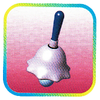Boo Bell: Difference between revisions
From the Super Mario Wiki, the Mario encyclopedia
Jump to navigationJump to search
m (Robot: Changing template: Foreignname) |
mNo edit summary |
||
| Line 2: | Line 2: | ||
The '''Boo Bell''' is an item that appears in ''[[Mario Party 2]]'' (and goes on to appear in ''[[Mario Party 3]]''). It rarely appears and can only be obtained in an Item [[Minigame]]. Its use is to ring for [[Boo]] and ask him to steal [[coin]]s or a [[Power Star|star]], depending on how much the player can afford. In ''Mario Party 3'', it appears more frequently, as it can be purchased from [[Koopa Kid]]. | The '''Boo Bell''' is an item that appears in ''[[Mario Party 2]]'' (and goes on to appear in ''[[Mario Party 3]]''). It rarely appears and can only be obtained in an Item [[Minigame]]. Its use is to ring for [[Boo]] and ask him to steal [[coin]]s or a [[Power Star|star]], depending on how much the player can afford. In ''Mario Party 3'', it appears more frequently, as it can be purchased from [[Koopa Kid]]. | ||
The Boo Bell | The Boo Bell is replaced by [[Boo's Crystal Ball]] in ''[[Mario Party 4]]''. | ||
{{br}} | {{br}} | ||
| Line 17: | Line 17: | ||
{{MP2}} | {{MP2}} | ||
{{MP3}} | {{MP3}} | ||
[[Category:Mario Party Items | [[Category:Mario Party 2 Items]] | ||
[[Category:Mario Party 3 Items]] | |||
[[Category:Mario Party 3]] | |||
Revision as of 05:16, August 5, 2017
The Boo Bell is an item that appears in Mario Party 2 (and goes on to appear in Mario Party 3). It rarely appears and can only be obtained in an Item Minigame. Its use is to ring for Boo and ask him to steal coins or a star, depending on how much the player can afford. In Mario Party 3, it appears more frequently, as it can be purchased from Koopa Kid.
The Boo Bell is replaced by Boo's Crystal Ball in Mario Party 4.
Name in Other Languages
| Language | Name | Meaning |
|---|---|---|
| Japanese | テレベル Tereberu |
Pormanteau of Teresa (Boo) and "bell". |
Trivia
- The Boo Bell may reference the medieval practice of burying the dead with a bell on a string tied to them (the bell being kept above-ground), so that if someone was buried alive, they could ring the bell so the grave keeper could dig them out.
| Mario Party 2 | |
|---|---|
| Main characters | Mario • Luigi • Princess Peach • Yoshi • Wario • Donkey Kong |
| Other characters | Bowser • Toad • Goomba • Boo • Koopa Troopa • Thwomp • Kamek • Whomp • Mr. I • Mushroom Genie • Steamer • Snifit Patrol • Shy Guy • Sushi • Baby Bowser • Woody • Professor Fungi • Battle T. • Totem Bros. |
| Items | Mushroom • Skeleton Key • Plunder Chest • Dueling Glove • Warp Block • Golden Mushroom • Magic Lamp • Boo Bell • Bowser Suit • Bowser Bomb |
| Spaces | Blue Space • Red Space • Item Space • Happening Space • Battle Space • Bowser Space • Star Space • Chance Time Space • Bank Space |
| Boards | Pirate Land • Western Land • Space Land • Mystery Land • Horror Land • Bowser Land • Rules Land |
| Other | Crazy Counting • Dinky Rinky • Goodness Rakes • Melon Mayhem • Nomiss • Gallery • Mario Land • Media • Minigames • In-game music • Pre-release and unused content • Quotes • Staff |
